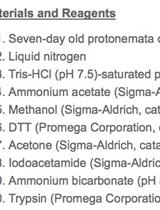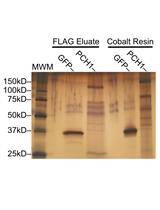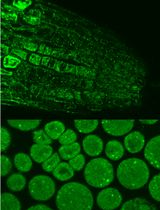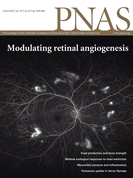- Submit a Protocol
- Receive Our Alerts
- Log in
- /
- Sign up
- My Bio Page
- Edit My Profile
- Change Password
- Log Out
- EN
- EN - English
- CN - 中文
- Protocols
- Articles and Issues
- For Authors
- About
- Become a Reviewer
- EN - English
- CN - 中文
- Home
- Protocols
- Articles and Issues
- For Authors
- About
- Become a Reviewer
Indirect Immunofluorescence Assay in Chlamydomonas reinhardtii
Published: Vol 6, Iss 13, Jul 5, 2016 DOI: 10.21769/BioProtoc.1864 Views: 13272
Reviewed by: Maria SinetovaCindy AstAnonymous reviewer(s)

Protocol Collections
Comprehensive collections of detailed, peer-reviewed protocols focusing on specific topics
Related protocols

A Phosphopeptide Purification Protocol for the Moss Physcomitrella paten
Xiaoqin Wang and Yikun He
Jul 20, 2015 9528 Views

Tandem Purification of His6-3x FLAG Tagged Proteins for Mass Spectrometry from Arabidopsis
He Huang and Dmitri Anton Nusinow
Dec 5, 2016 13565 Views

Immunofluorescence for Detection of TOR Kinase Activity In Situ in Photosynthetic Organisms
Ana P. Lando [...] Giselle M. A. Martínez-Noël
Dec 20, 2024 1769 Views
Abstract
Determining the protein localization is essential to elucidate its in vivo function. Fluorescence-tagged proteins are widely used for it, but it is sometimes difficult to express tagged proteins in Chlamydomonas. Alternatively, indirect immunofluorescence assay is also one of the widely used methods and many reports determining the localization of Chlamydomonas proteins using this method are published. Here, we introduce a protocol of indirect immunofluorescence assay adapted from our papers reporting LCIB (CO2-recycling factor in the vicinity of pyrenoid; Yamano et al., 2010), LCI1 (plasma membrane-localized inorganic carbon transporter; Ohnishi et al., 2010), HLA3 (plasma membrane-localized ABC-type bicarbonate transporter; Yamano et al., 2015), and LCIA (chloroplast envelope anion channel; Yamano et al., 2015) in Chlamydomonas reinhardtii. The protocol described here could be useful for observing the protein of interest in other algae cells.
Keywords: Chloroplast membraneMaterials and Reagents
- Poly-L-lysine-treated glass slide (Poly-Prep Slides) (Sigma-Aldrich, catalog number: P0425-72EA )
- Coverslips (Matsunami Glass, catalog number: C218181 )
- Dako Pen (Dako, catalog number: S2002 )
- Plastic box (9 cm x 19 cm x 4 cm)
Note: In this experiment, but any size is OK. - Kimwipes® paper (Kimberly Clark)
- Chlamydomonas cells of interest
- Hematocytometer (Erma, catalog number: 03-303-6 )
- Phosphate-buffered Saline (PBS)
- Tween-20 (Santa Cruz, catalog number: sc-29113 )
- PBS-T (PBS with 0.1% Tween-20)
- Paraformaldehyde (Nacalai Tesque, catalog number: 26126-54 )
- Methanol (Nacalai Tesque, catalog number: 21915-64 )
- Globulin-free Bovine Serum Albumin (BSA) (Nacalai Tesque, catalog number: 01281-26 )
- Affinity-purified rabbit primary antibody against LCIB (Yamano et al., 2010)
- Goat anti-Rabbit IgG (H+L) Secondary Antibody, Alexa Fluor® 488 conjugate (Thermo Fisher, catalog number: A-11001 )
- Mounting medium (Vectorshield, catalog number: H-1300 )
- 4% formaldehyde (see Recipes)
- PBS (see Recipes)
- PBS-T (see Recipes)
- Blocking solution (see Recipes)
Equipment
- Coplin jar (50 ml size)
- Fluorescence microscopy Axioscope2 (Zeiss) with a specific filter set (excitation bandpass
480/40 and emission band pass 527/30) or laser scanning confocal microscopy TCS SP8
(Leica) with a 488 nm laser line
Note: these were the instruments used throughout our experiments, but any company is OK.
Procedure
- Chill 100% methanol in a Coplin jar at -20 °C for at least 4 h.
- Harvest 50 ml of Chlamydomonas cells at the log growth phase by centrifugation at 600 x g for 5 min. This and subsequent steps are performed at room temperature except for step 10.
Notes: - Chlamydomonas culture media recipes are available at http://www.chlamy.org/media.html.
- 50 ml of cultured cells grown to 1-2 x 106 cells ml–1 is adequate.
- Resuspend the cells in small volumes (1-2 ml) of PBS, count the cell number by hematocytometer, and adjust the cell density at 1x107 cells ml–1 using PBS.
- Draw three circles on a Poly-L-lysine-treated glass slide with Dako Pen to provide a barrier to liquids such as blocking solution, antibody solution, and washing buffer (Figure 1A). Dry the circles at room temperature.
- Put 100 µl of Chlamydomonas cell suspension in each circle and let them air-dry for 5 min to fix the cells to the glass.
Note: If you let them sit longer, more Chlamydomonas cells will adhere, but the ends of the flagella of cells start to curl up. - Permeabllize the cells by immersing the glass slide into a Coplin jar filled with PBS-T for 10 min (Figure 1B).
- Prepare a clean plastic box with a few damp Kimwipes® paper at the bottom to keep the air humid.
- Place the glass slide on a cap of plastic tube placed in the plastic box (Figure 1C) and fix the proteins within cells by applying 100 µl of PBS containing 4% (w/v) formaldehyde to the cells for 20 min. Make sure that the solution is within the circles and the entire cells are covered by the PBS solution.

Figure 1. Devices for indirect immunofluorescence assay. A. Example of circles drawn by Dako Pen on a Poly-L-lysine-treated glass slide. B. Immersed glass slide in a Coplin jar filled with PBS-T. C. Humid plastic box with a few damp Kimwipes® papers and a glass slide on a cap of plastic tube. - Wash the cells two times by immersing the glass slide into a Coplin jar filled with PBS for 5 min.
Note: You do not need to shake the slides or jars during washing. - Fix the cells by immersing the glass slide into a Coplin jar filled with pre-chilled 100% methanol at -20 ˚C for 20 min. Because chlorophyll will be solubilized, the methanol becomes green.
Note: Because the temperature of the chilled methanol is important in the fixation, it is recommended to keep the methanol in a freezer at -20 ˚C overnight before use. - Rehydrate the cells by immersing the glass slide into a Coplin jar filled with PBS for 5 min.
- Pour off the PBS and repeat the rehydration step 11 two times. If you perform time-course experiments, you can let the glass slide sit in PBS for several hours until you are ready.
- Take out the glass slide from the Coplin jar and let it air-dry for 5 min.
- Block the cells on the glass slide by applying 100 µl of blocking solution for 1 h in the humid plastic box.
- Wash the cells two times by immersing the glass slide into a Coplin jar filled with PBS for 5 min.
Note: You do not need to shake the slides or jars during washing. - Take out the glass slide from the Coplin jar and let it air-dry for 5 min.
- Apply 50 µl of PBS-T containing the primary antibody at the dilution rate of 1:500 and incubate the cells for 1 h in the humid plastic box.
- Wash the cells six times by immersing the glass slide into a Coplin jar filled with PBS-T for 5 min.
- Apply 50 µl of PBS-T containing secondary antibody at the dilution rate of 1:500 and incubate the cells for 1 h in the humid plastic box. Keep in the dark.
- Wash the cells six times by immersing the glass slide into a Coplin jar filled with PBS-T for 5 min.
- Apply 15 µl of mounting solution to the cells. Make sure that no air bubbles are formed.
- Cells are now ready for observation by fluorescent microscopy with a specific filter set (excitation bandpass 480/40 and emission bandpass 527/30) or laser scanning confocal microscopy with a 488 nm laser line. Glass slide can be stored for a week at 4 °C in the dark.

Figure 2. Actual cell images and fluorescence signals of indirect immunofluorescence assay. A. Fixed cells on the glass slide after step 5. Scale bar, 10 µm. B. Fixed cells on the glass slide after step 10. Chlorophyll pigments are extracted and the color of the cells turn transparent. Scale bar, 10 µm. C. Differential interference contrast image of Chlamydomonas cell. Arrowhead indicates the pyrenoid structure where CO2-fixation enzyme Rubisco is enriched. Scale bar, 5 µm. D. Indirect immunofluorescence signals derived from anti LCIB-antibody. LCIB is detected as a ring-like structure around the pyrenoid as shown in the previous report (Yamano et al., 2010). Scale bar, 5 µm.
Notes
We highly recommend that user also performs the same experiment using a target gene mutant as a negative control to distinguish true signals from artifact.
Recipes
- 4% formaldehyde
- Heat 80 ml of PBS to approximately 60 °C on a stir plate.
- Add 4 g of paraformaldehyde and slowly raise the pH by adding 1 N NaOH until the solution becomes clear.
- After dissolving, cool and filter the solution.
- Fill up the volume to 100 ml with PBS and adjust the pH with diluted HCl to approximately 6.9.
- Aliquoted solutions can be kept at -20 °C for a month.
- PBS
Dissolve 8 g of NaCl, 0.2 g of KCl, 1.44 g of Na2HPO4, and 0.24 g of KH2PO4 in 900 ml of distilled H2O. Adjust the pH to 7.4 with HCl and add H2O to 1L. - PBS-T
Add 0.1% Tween-20 (v/v) to PBS. - Blocking solution
5% (w/v) globulin-free BSA in PBS buffer
Acknowledgments
We thank Lianyong Wang for technical assistance. This work was supported by the Japan Society for the Promotion of Science KAKENHI Grants 25120714 (to H.F.) and 25840109 (to T.Y.) and the Japan Science and Technology Agency Advanced Low Carbon Technology Research and Development Program.
References
- Ohnishi, N., Mukherjee, B., Tsujikawa, T., Yanase, M., Nakano, H., Moroney, J. V. and Fukuzawa, H. (2010). Expression of a low CO(2)-inducible protein, LCI1, increases inorganic carbon uptake in the green alga Chlamydomonas reinhardtii. Plant Cell 22(9): 3105-3117.
- Shakes, D. C., Miller, D. M., 3rd and Nonet, M. L. (2012). Immunofluorescence microscopy. Methods Cell Biol 107: 35-66.
- Yamano, T., Tsujikawa, T., Hatano, K., Ozawa, S., Takahashi, Y. and Fukuzawa, H. (2010). Light and low-CO2-dependent LCIB-LCIC complex localization in the chloroplast supports the carbon-concentrating mechanism in Chlamydomonas reinhardtii. Plant Cell Physiol 51(9): 1453-1468.
- Yamano, T., Sato, E., Iguchi, H., Fukuda, Y. and Fukuzawa, H. (2015). Characterization of cooperative bicarbonate uptake into chloroplast stroma in the green alga Chlamydomonas reinhardtii. Proc Natl Acad Sci U S A 112(23): 7315-7320.
Article Information
Copyright
© 2016 The Authors; exclusive licensee Bio-protocol LLC.
How to cite
Yamano, T. and Fukuzawa, H. (2016). Indirect Immunofluorescence Assay in Chlamydomonas reinhardtii. Bio-protocol 6(13): e1864. DOI: 10.21769/BioProtoc.1864.
Category
Plant Science > Plant biochemistry > Protein > Labeling
Biochemistry > Protein > Immunodetection > Immunostaining
Cell Biology > Cell imaging > Fluorescence
Do you have any questions about this protocol?
Post your question to gather feedback from the community. We will also invite the authors of this article to respond.
Share
Bluesky
X
Copy link










